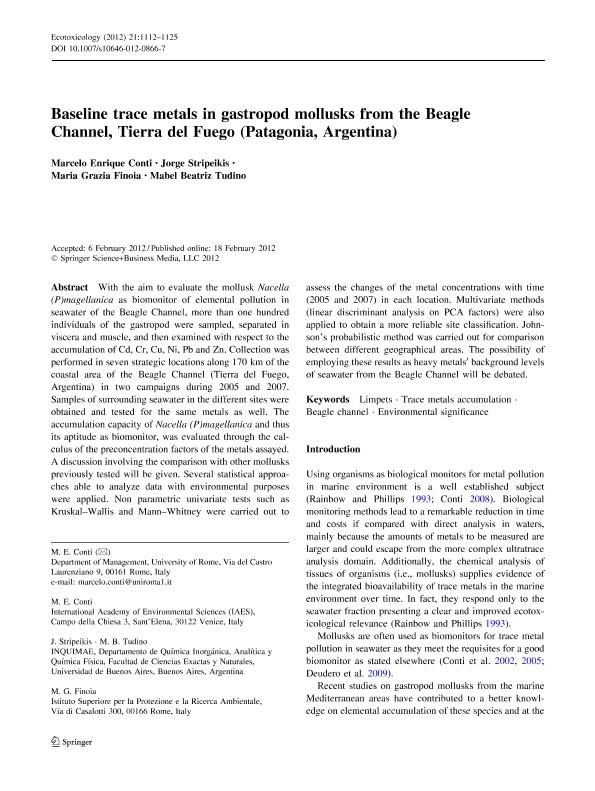Mostrar el registro sencillo del ítem
dc.contributor.author
Conti, Marcelo Enrique
dc.contributor.author
Stripeikis, Jorge Daniel

dc.contributor.author
Finoia, Maria Grazia
dc.contributor.author
Tudino, Mabel Beatriz

dc.date.available
2019-01-08T21:07:45Z
dc.date.issued
2012-05
dc.identifier.citation
Conti, Marcelo Enrique; Stripeikis, Jorge Daniel; Finoia, Maria Grazia; Tudino, Mabel Beatriz; Baseline trace metals in gastropod mollusks from the Beagle Channel, Tierra del Fuego (Patagonia, Argentina); Springer; Ecotoxicology; 21; 4; 5-2012; 1112-1125
dc.identifier.issn
0963-9292
dc.identifier.uri
http://hdl.handle.net/11336/67729
dc.description.abstract
With the aim to evaluate the mollusk Nacella (P)magellanica as biomonitor of elemental pollution in seawater of the Beagle Channel, more than one hundred individuals of the gastropod were sampled, separated in viscera and muscle, and then examined with respect to the accumulation of Cd, Cr, Cu, Ni, Pb and Zn. Collection was performed in seven strategic locations along 170 km of the coastal area of the Beagle Channel (Tierra del Fuego, Argentina) in two campaigns during 2005 and 2007. Samples of surrounding seawater in the different sites were obtained and tested for the same metals as well. The accumulation capacity of Nacella (P)magellanica and thus its aptitude as biomonitor, was evaluated through the calculus of the preconcentration factors of the metals assayed. A discussion involving the comparison with other mollusks previously tested will be given. Several statistical approaches able to analyze data with environmental purposes were applied. Non parametric univariate tests such as Kruskal-Wallis and Mann-Whitney were carried out to assess the changes of the metal concentrations with time (2005 and 2007) in each location. Multivariate methods (linear discriminant analysis on PCA factors) were also applied to obtain a more reliable site classification. Johnson's probabilistic method was carried out for comparison between different geographical areas. The possibility of employing these results as heavy metals0 background levels of seawater from the Beagle Channel will be debated. © Springer Science+Business Media, LLC 2012.
dc.format
application/pdf
dc.language.iso
eng
dc.publisher
Springer

dc.rights
info:eu-repo/semantics/openAccess
dc.rights.uri
https://creativecommons.org/licenses/by-nc-sa/2.5/ar/
dc.subject
Beagle Channel
dc.subject
Environmental Significance
dc.subject
Limpets
dc.subject
Trace Metals Accumulation
dc.subject.classification
Otras Ciencias Biológicas

dc.subject.classification
Ciencias Biológicas

dc.subject.classification
CIENCIAS NATURALES Y EXACTAS

dc.subject.classification
Otras Ciencias Químicas

dc.subject.classification
Ciencias Químicas

dc.subject.classification
CIENCIAS NATURALES Y EXACTAS

dc.title
Baseline trace metals in gastropod mollusks from the Beagle Channel, Tierra del Fuego (Patagonia, Argentina)
dc.type
info:eu-repo/semantics/article
dc.type
info:ar-repo/semantics/artículo
dc.type
info:eu-repo/semantics/publishedVersion
dc.date.updated
2019-01-02T19:10:38Z
dc.journal.volume
21
dc.journal.number
4
dc.journal.pagination
1112-1125
dc.journal.pais
Alemania

dc.journal.ciudad
Berlin
dc.description.fil
Fil: Conti, Marcelo Enrique. Università di Roma; Italia. International Academy of Environmental Sciences; Italia
dc.description.fil
Fil: Stripeikis, Jorge Daniel. Consejo Nacional de Investigaciones Científicas y Técnicas. Oficina de Coordinación Administrativa Ciudad Universitaria. Instituto de Química, Física de los Materiales, Medioambiente y Energía. Universidad de Buenos Aires. Facultad de Ciencias Exactas y Naturales. Instituto de Química, Física de los Materiales, Medioambiente y Energía; Argentina
dc.description.fil
Fil: Finoia, Maria Grazia. Istituto Superiore per la Protezione e la Ricerca Ambientale; Italia
dc.description.fil
Fil: Tudino, Mabel Beatriz. Consejo Nacional de Investigaciones Científicas y Técnicas. Oficina de Coordinación Administrativa Ciudad Universitaria. Instituto de Química, Física de los Materiales, Medioambiente y Energía. Universidad de Buenos Aires. Facultad de Ciencias Exactas y Naturales. Instituto de Química, Física de los Materiales, Medioambiente y Energía; Argentina
dc.journal.title
Ecotoxicology

dc.relation.alternativeid
info:eu-repo/semantics/altIdentifier/doi/https://dx.doi.org/10.1007/s10646-012-0866-7
dc.relation.alternativeid
info:eu-repo/semantics/altIdentifier/url/https://link.springer.com/article/10.1007/s10646-012-0866-7
Archivos asociados
